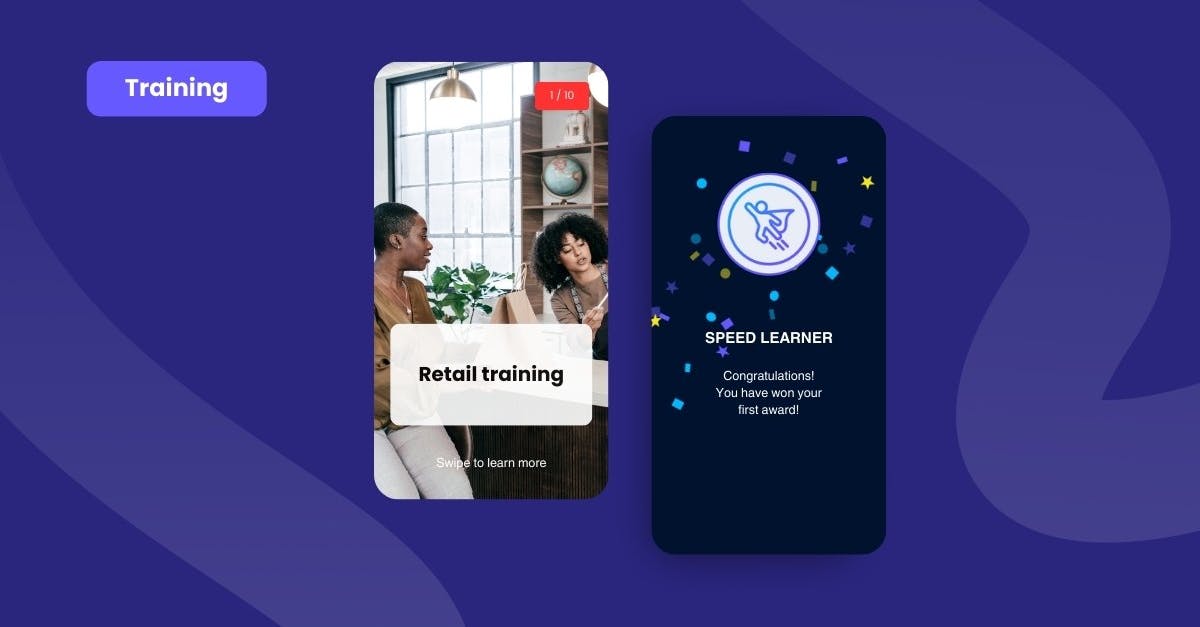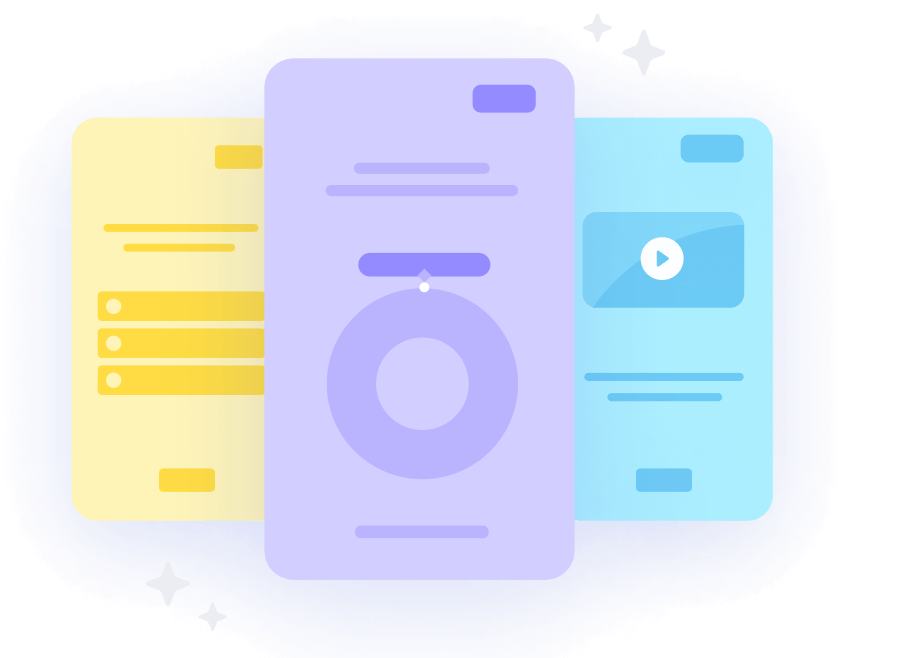How to learn with active recall and spaced repetition
Published
May 25, 2023
Author
Share

Are you tired of your team forgetting important information right after they learn it? Do you want them to improve their memory and retain knowledge for longer periods of time? If so, consider using active recall and spaced repetition techniques.
In this article, we’ll discuss what these techniques are, how they work, and how you can use them to improve your learning and memory.
What does "active recall" mean? What does it do for learning?
Active recall is a learning technique that involves actively retrieving information from your memory rather than simply reviewing it. This technique is based on the idea that the act of retrieving information from memory strengthens the neural pathways associated with that information, making it easier for knowledge retention. Active recall can be achieved through various methods, such as flashcards, quizzes, and self-testing.
Active recall studying works by forcing your brain to retrieve information from memory instead of simply recognizing it. When you engage in active recall, you are essentially practicing the act of remembering, which strengthens the neural pathways associated with that information. This makes it easier to recall the information in the future, even after a long period of time has passed.
How does spaced repetition work? How is it good for learning?
Spaced repetition operates by delivering knowledge at increasing time intervals, with greater gaps between reviews as the material is successfully remembered. This strategy makes use of the spacing effect, which is the tendency for information to be recalled better when presented in spaced-out intervals rather than all at once. Spaced repetition encourages more effective consolidation and retention of knowledge by spacing out reviews.
It’s a more efficient way to learn and retain information than cramming or mass studying. Secondly, it allows for long-term retention of information, making it useful for learning new skills or languages. It can even be customized to fit individual learning needs and preferences.
Is active recall the same as the spaced repetition system? Is active recall the best way to learn?
While these terms are often interchangeable, active recall and spaced repetition aren’t the same thing, but they are often used together as complementary learning techniques.
Active recall involves actively retrieving information from memory, while spaced repetition involves spacing out review sessions over time to maximize retention. By combining these two techniques, you can strengthen your team’s memory and retain information for longer periods of time.
If you want to use them together, you can start by creating flashcards or a study guide using active recall. Then, use an active recall and spaced repetition app or make a spaced repetition schedule.
As for whether active recall is the best way to learn, it depends on the individual and the type of information being learned. Active recall can be a highly effective way to learn and retain information, but it may not work for everyone or for every type of material. It’s always a good idea to experiment with different learning techniques to find what works best for your learners.
Tips for Using Active Recall and Spaced Repetition
If you’re not familiar with how to use active recall and spaced repetition, it can be a bit overwhelming to implement. Here are some of our tips to make it easier for you:
- Start with clear learning objectives: Define your learning objectives and identify the key concepts that your team needs to master.
- Chunk information: Break information down into smaller chunks or categories, and organize them in a logical sequence.
- Use active recall to test your team’s knowledge retention: Once they’ve learned a chunk of information, test them by actively recalling the information without looking at their notes or resources. This will help to strengthen their memory and reinforce learning.
- Use spaced repetition: Review the information at increasing intervals of time, starting with shorter intervals (e.g., every few hours) and gradually increasing the interval (e.g., every few days, every few weeks, etc.). This is great for making sure the learning material enters your team’s long-term memory.
- Mix up the order: Instead of reviewing information in the same order every time, mix up the order to challenge them and enhance retention.
- Use different active recall and spaced repetition methods: Use a variety of techniques to reinforce learning, such as flashcards, quizzes, and practice problems.
- Take breaks: Take regular breaks during learning sessions to avoid burnout and increase the chances of knowledge retention.
- Get enough sleep: Sleep is crucial for consolidating memories, so make sure to get enough sleep to help your brain process and retain new information.
What’s the best app for active recall and spaced repetition?
There are several great apps available for active recall and spaced repetition, depending on your needs and preferences. Here are a few popular options:
1. SC Training
SC Training is a mobile learning platform that includes a variety of features designed to maximize knowledge retention. It also maximizes learner engagement with the help of active recall and spaced repetition.
SC Training's spaced repetition algorithm adapts to each learner's individual needs, ensuring that they’re reviewing content at optimal intervals for retention. The app also includes gamification elements and achievement features like badges and banners to motivate learners and enhance engagement.
Additionally, SC Training offers a range of other features that can enhance learning, such as microlearning modules, interactive content, and practical assessments. Learning content is also highly customizable, allowing organizations to tailor the content and branding to their specific needs.
If you're a large organization searching for the best spaced repetition tool for workplace learning, SC Training's perfect for you. This feature can be made available through request only.
Start your team’s active recall and spaced repetition journey with SC Training today.
2. Anki
Anki is a learning platform that’s widely used by students, professionals, and researchers around the world. With Anki, you can create your own flashcards, which can include text, images, and audio. Its spaced repetition algorithm adjusts the frequency of review based on how well your team remembers each card.
It improves the learning process, allowing your team to retain more information in less time. This means that they’ll see cards more often if they struggle with them, and less often if they remember them well. Anki also encourages active recall by presenting the question first and then allowing you to test yourself before revealing the answer.
3. Quizlet
With Quizlet, users can create custom study sets that include a variety of content types, including text, images, and audio. These study sets can then be used to practice active recall, where your learners test their knowledge by answering questions and attempting to recall information from memory.
Like the rest on this list, Quizlet also includes a spaced repetition algorithm that adjusts the frequency of review based on how well the user remembers each piece of information. This means that users will see information more often if they struggle with it and less often if they remember it well. This approach has been shown to be effective in enhancing retention and long-term learning.
4. Memrise
Memrise is a language learning platform that uses gamification and spaced repetition to help users learn a new language. The platform offers a range of courses in various languages, and each course includes a series of lessons that are designed to gradually build the user's vocabulary and grammar skills.
One of the key features of Memrise is its use of gamification elements, such as points, badges, and leaderboards, to make the learning process more engaging and fun. This can help keep users motivated and encourage them to continue learning over time.
5. SuperMemo
SuperMemo works by breaking information down into small, manageable pieces, called "items," and then scheduling review sessions for each item based on the user's performance. The program uses a complex algorithm to determine the optimal time for each review session, with the goal of maximizing retention and minimizing the time required for study.
One of the key benefits of SuperMemo is its ability to adapt to the learner’s individual learning needs and preferences. The program allows you to create custom learning materials and adjust the difficulty level of each item, guaranteeing that your learners are always challenged but not overwhelmed.
SC Training is a spaced repetition system designed for today’s digital habits, delivering more engaging and effective micro-learning directly to learners anytime and anywhere.
Sign up for this spaced repetition system today.
Author
Stephanie Escuadro
Stephanie is an eLearning content writer for SC Training (formerly EdApp), a microlearning solution designed for today's digital habits. She creates content about cutting-edge learning technologies and resources to help companies deliver great training experiences. When not absorbed in writing, she spends her time taking care of her dog and binge-watching.
